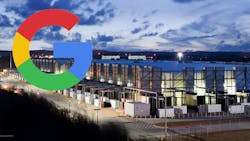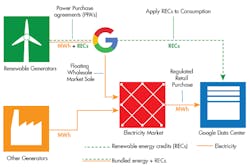This file type includes high resolution graphics and schematics when applicable.
When I first heard about Google’s latest announcement, I thought the company was going to rely completely on renewable energy to directly energize its data centers. I was surprised by such an achievement, as data centers operate 24/7 and wind and the sun are not constantly available resources. But it turned out that is not the case—yet. Google’s renewable energy plan is just an excuse for all the greenhouse gas (GHG) emissions that it will keep generating as it mostly energizes its data centers with fossil fuels. In addition to delving into the significance of this announcement ourselves, we asked some experts to weigh in on this trend and the reasons that data-center owners are making these moves.
To provide some background, owners of big data centers like Google had started to rely progressively on renewable sources because data centers require such significant amounts of energy. In 2015, Google consumed 5.7 terawatt-hours (TWh) of electricity, which is nearly as much electricity as the city of San Francisco used in the same year. Google’s long-term goal is to run on clean, zero-carbon energy full-time, every day of the year. To achieve the 100% renewable energy purchasing goal, Google is currently participating in a number of large-scale deals with renewable producers and partnerships with utility providers such as:
- A “direct” renewable purchase in competitive retail markets in areas with deregulated wholesale and retail power markets
- A fixed-floating swap approach, whereby Google buys fixed-price renewables directly from a wind or solar farm and then resells it into the wholesale market at a floating market rate, retiring the associate renewable energy certificates (RECs). It then sells the power back into the same grid from which we later draw power at the consumer level.
“From a physical perspective, this is just as good as consuming the renewable energy directly. That’s because electricity on a grid is fungible; electrons generated in one spot can’t be directed to any specific user on the grid, any more than a cup of water poured into a river could be directed to a particular stream. So it doesn’t make much of a difference where the renewable energy that we buy is located, as long as it’s on the same grid as our data center,” says Gary Demasi, director of Data Center Energy and Location Strategy for Google.
But not many people agree with Google’s approach on renewable energy and its description of electricity on a grid as “fungible.” In a blog on The Huffington Post, Ed Kraples, founder and CEO of Anbaric, states, “Essentially, Google is contracting for green energy from places that can never reach its data centers. If it were as simple as Google claims, it would be easy to build a renewable power sector. New York City could execute a massive number of contracts with wind farms in upstate New York because they are on the same grid. “
Basically, Google is promising to buy—on an annual basis—the same amount of megawatt-hours (MWh) of renewable energy as the amount of megawatt-hours of electricity that it consumes for its worldwide operations. This approach will benefit the renewable energy market even though it is still generating the same amount of greenhouse gas (GHG) emissions with or without its 100% renewable energy purchasing plan. By purchasing energy from not-yet-constructed generation facilities, Google will promote the advancement of new technologies. In the long term, it also should generate new green power on the grid while spurring economic growth and new employment opportunities.
Why Buy Renewable?
Many are speculating about why the owners of the largest data centers are including renewable energy: Is it because it gives them very good publicity? Or is it because renewable energy is getting cheaper and easily scalable? While renewable energy is becoming cheaper to produce, does it mean we are getting closer to replacing fossil fuels with renewable energy? Dr. Eduard Oró, an energy consultant from Catalonia Institute for Energy Research in Spain, was a speaker at one of the sustainability sessions. He gave us his take on the future of renewable energy and data centers:
“The data-center industry is really traditional and business-focused, so they are really concentrated on their business, which is providing IT services. It is really difficult (I would say impossible) to find any data center operator/maintenance whose first priority is energy efficiency. They try to cover their backs, and therefore they prefer to install another chiller rather than an energy management system which controls and optimizes the overall system. You have to think that Uptime Institute, the worldwide-reference for data center advisory organization, came from CAT—so big machines and diesel-generators. If you want to be a top data center (getting TIER IV certified), you should install redundancy systems that are connected all day long, so it is impossible to be energy-efficient.”
Oró continues, “From my humble opinion, just big players are worried about implementing renewables into their portfolio. But it’s more a corporate social responsibility rather than install on-site renewables on the data center. They prefer to invest in wind turbines far away or to get a green-agreement with some electricity company rather than build up a Net Zero Energy Data Center from scratch.
“But I don’t want to be negative,” Oró adds. “There are many initiatives in the private industry and also in governments (in particular the European Commission) to bring more renewables into the data center industry. It would be difficult but we are working on that. For instance, at IREC, we have coordinated RenewIT, which is an EU-funded project aiming to spread the knowledge and break the technical and industry barriers about implementing renewables into the data center portfolio.”
There are many reasons for big-scale data centers to include renewable energy and it seems that the day that renewable energy will replace fossil fuel is getting closer as investments in renewable energy soar, new technology innovations emerge, and renewable energy subsidies increase. If regulated utilities offer better retail options to purchase renewable energy, many small and medium data centers will benefit. And with more demand, renewable energy will become sustainable and affordable.
This file type includes high resolution graphics and schematics when applicable.
About the Author
Maria Guerra
Power/Analog Editor
Maria Guerra is the Power/Analog Editor for Electronic Design. She is an Electrical Engineer with an MSEE from NYU Tandon School of Engineering. She has a very solid engineering background and extensive experience with technical documentation and writing. Before joining Electronic Design, she was an Electrical Engineer for Kellogg, Brown & Root Ltd (London. U.K.). During her years in the Oil and Gas Industry she was involved in a range of projects for both offshore and onshore designs. Her technical and soft skills bring a practical, hands-on approach to the Electronic Design team.




